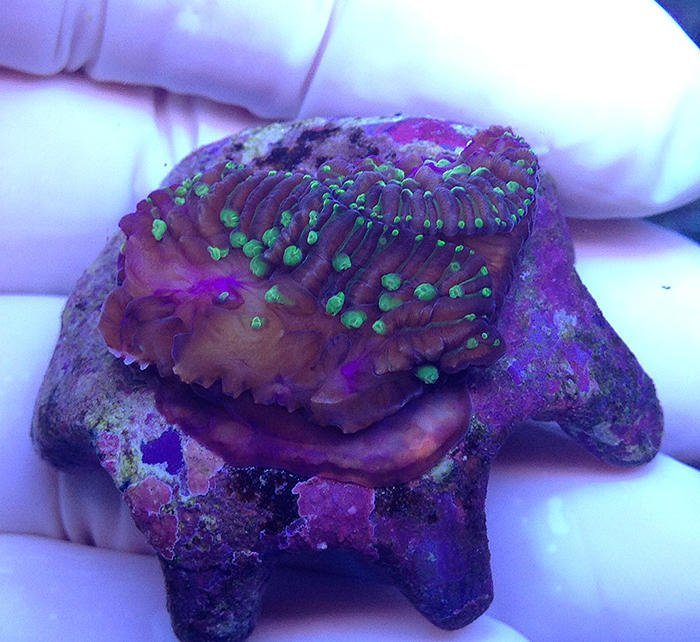- Joined
- Jan 24, 2020
- Messages
- 590
- Reaction score
- 281
How are vendors grafting acros like the rainbow splice? I think this is super intresting and I'm curious.
Follow along with the video below to see how to install our site as a web app on your home screen.
Note: This feature may not be available in some browsers.


What's the history behind JKR Rainbow being grafted? I have a large colony and it doesn't appear to be grafted at all. RRC Rainbow Splice has been around for at least 3 years now. No fear on it losing it's colors LOL.Grafts usually end up mono colored over time... not always, but usually. Zoox infusions can stay, but sometimes the original host can just take over and the introduced color can disappear - again, a crap shoot. I would not pay too much for some of these since you just honestly don't know what you are going to get over time... sometimes awesome, but most of the time just blah.
Joe Knows Reefs Rainbow is a grafted coral that has kept it color over at least a decade. I think that it is safe to say that this one might make it.

Here's the info on it. It was possibly grafted, but not intentionally, and this information is from 2011. I highly doubt that it is an actual grafted coral.There are photos of the JKR Rainbow on Reef Farmers website where you can see the two different corals and where the graft happened... no idea if that site is still up. I used to know the two species, but I have long forgotten.
There was a JKR Rainbow 2.0 that was even better, but I think that it has all but died out. I have not seen it in a long time. It was awesome. It looks like a typical A. Plana with many bright colors and not a graft.
It is rare that a corals takes the color of another and assimilates it fully. You usually just get colored streaks and eventually when the streak ends, then so does the two colors. You see this with most montis and millepora that have been grafted. Sometimes, a coral will accept some of the other coral for good, but this is more rare.
They aren't. Grafting corals rarely if ever works. The Rainbow Splice is the results of a Green Florescent Protein infection. You can read about it here https://reefbuilders.com/2019/01/10/the-rainbow-splice-acropora-millepora-from-reef-raft-canada/
Hey there - sorry to resurrect this thread from the dead.Green fluorescent protein is not infectious. I worked in the lab where its structure was determined back in the 90's. It's just a protein that fluoresces green when blue light shines on it. It has no way to move on its own between coral colonies.
Proteins that produce pigment can be transferred between corals via thraustochytrids (and possibly phages) and I have witnessed this between Montipora confusa colonies (GFP transferred across the tank from a green colony to a purple colony which then became green-with-purple-highlights). I've never seen this between Acropora species, though. Interestingly, I tried to graft frags of the two confusas together and they refused to fuse, eventually trying to overgrow each other.
Grafting corals can be done but is rarely successful and very much species specific. Adult corals have well developed immune systems that usually prevent this. There was a good talk on it by Justin Grabel at MACNA 2016.
Another option to explain the Rainbow Splice and "grafted" colonies is a coral chimera, where multiple baby corals (planulae) originally settled together and fused, eventually making a coral with multiple genomes. Corals do not form an immune system until they are larger, allowing this to happen. Chimerism provides a survival advantage in the wild with increased growth rate and colony size when compared to non-chimeric colonies. Individual genomic traits are are usually expressed mixed (swirled) throughout the eventual fusion colony. Some of Dr. Jamie Craggs spawned colonies he has grown out have this appearance, indicating that they are chimeric.
If your interested, here's a nice paper on coral chimeras in Acropora millepora:
I believe the idea of their involvement was floated in this article:Hey there - sorry to resurrect this thread from the dead.
Been studying grafting lately and unfortunately it seems you really have to dig for anything beyond superficial. If anything is apparent it's that the term "grafting" ambiguously refers to a whole umbrella of diverse biological phenomenon. Your post hinted at some things I haven't seen before though. I hope you don't mind if I ask you some questions on the topic.
First of all, if there are any research papers or textbooks or something you can point me in the direction of instead of answering my questions, I would be appreciative of that.
Thraustochytrids. I did some basic research on them and it seems they are an ordinary eukaryotic member of the reef food chain. What makes them "special", i.e. having a potential ability to transfer pigmentation/proteins? My first thought are these types of pigment transfers plausibly involve some genomic element, so bacteria phages would make a lot more sense in my head. Or even another of the multiple bacterial genomic mechanism. I did see that potential parasitic relationships between marine animals and thraustochytrids is a topic of investigation, but no conclusive evidence found in that area, and it would strike me as odd that this "GFP grafting" is a result of some parasitic relationship.
Sorry if this is basic knowledge and I may be out of my league but if that's the case some direction to reading material would be very appreciated. Thanks for your time!

